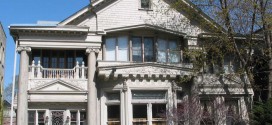The Cabbagetown Northwest Conservation District is abundant with cherished Victorian homes. This neighbourhood’s rich diversity of 19th-century properties coalesce into one distinct identity for Toronto. Architectural styles such as the Bay and Gable, Gothic Revival, Second Empire, Georgian, and Worker’s Cottage are common in this area; however, there are three properties in the heritage district that stand-out from the rest: 29 Aberdeen Avenue, 216 Carlton Street, and 5-7 Millington Street. What’s so special about these homes is that they are examples of contemporary architecture; they mark the turn of the 20th-century in Cabbagetown. Contemporary Architecture Characteristics Defining contemporary architecture is …
Read More »The Homes of Wellesley Cottages
A large portion of the properties on Amelia Street are either influenced by or are strict forms of the worker’s cottage (some times referred to as the working man’s cottage). We’ve reviewed many of these homes before — so it is now time to turn our attention on the comely blue-trimmed, white-walled rowhouses of Wellesley Cottages laneway, located north-east of the Sackville St. and Wellesley St. East crossing. Dating back to 1887, the homes on Wellsey Cottages emit vibes of a small Victorian village, hidden off the main path, both beautiful and undisturbed. Each property is an idealistic example of …
Read More »John Douglas House: Classical Revival in Cabbagetown
The John Douglas House stands placidly in the heart of the Cabbagetown Metacalfe Heritage Conservation District as a 2 storey residential rowhouse of unique Classical Revival features. Unlike many other prominent styles in Cabbagetown, the Classical Revival trend can only be found at this location and one other — the Canadian Bank of Commerce on Carlton Street. Interestingly enough, the John Douglas House was first modelled after the Italianate style in 1875. It wasn’t until 1891, when architect John Wilson Gray took the initiative to remodel, that the home transformed into an example of Classical Revival, which by that point had become outdated. By …
Read More » Cabbagetown Info Events, reviews and what's happening in Cabbagetown, Toronto
Cabbagetown Info Events, reviews and what's happening in Cabbagetown, Toronto



